 Toyota Camry XV30 (2002–2006) Service ManualIgnition
Toyota Camry XV30 (2002–2006) Service ManualIgnition
Ignition system (1MZ−FE/3MZ−FE)
Ignition system (1MZ−FE/3MZ−FE)
ON−VEHICLE INSPECTION
NOTICE: In this section, the terms “cold” and “hot” refer to the temperature of the coils. “Cold” means approximately −10 C (14 F) to 50 C (122 F). “Hot” means approximately 50 C (122 F) to 100 C (212 F).
1. INSPECT IGNITION COIL ASSY (WITH IGNITER) AND PERFORM SPARK TEST
a. Check for DTCs.
NOTICE: If a DTC is present, perform troubleshooting in accordance with the procedure for that DTC
.
b. Check if sparks occur.
- Remove the V−bank cover.
- Remove the intake air surge tank.
- Remove the ignition coils.
- Using a 16 mm (0.63 in.) plug wrench, remove the spark plugs.
- Install the spark plugs to each ignition coil and connect the ignition coil connectors.
- Disconnect the 6 injector connectors.
- Ground the spark plugs.
- Check if sparks occur at each spark plug while the engine is being cranked.
NOTICE: Do not crank the engine for more than 2 seconds.
If sparks do not occur, perform the following test:
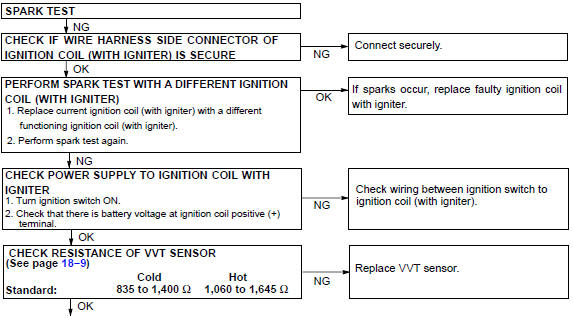

- Using a 16 mm (0.63 in.) plug wrench, install the spark plugs.
Torque: 25 N·m (255 kgf·cm, 18.5 ft·lbf)
- Install the ignition coil.
Torque: 8.0 N·m (82 kgf·cm, 71 in.·lbf)
- Install the intake air surge tank
- Install the V−bank cover
INSPECTION
NOTICE: In this section, the terms “cold” and “hot” refer to the temperature of the coils. “Cold” means approximately −10 C (14 F) to 50 C (122 F). “Hot” means approximately 50 C (122 F) to 100 C (212 F).
1. INSPECT SPARK PLUG
NOTICE:
- Do not use a wire brush for cleaning.
- Do not attempt to adjust the electrode gap of a used spark plug.
a. Check the electrode.
1. Using an ohmmeter, measure the insulation resistance.
Correct insulation resistance: 10 MW or more
If the resistance is less than the specified value, proceed to step d..
HINT: If the ohmmeter is not available, perform the following simple inspection instead.
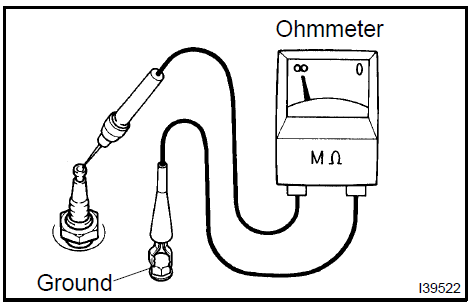
b. Alternative inspection method:
- Quickly accelerate the engine to 4,000 rpm 5 times.
- Remove the spark plug.
- Visually check the spark plug.
- If the electrode is dry, the spark plug is functioning.
Proceed to step 2.
- If the electrode is damp, proceed to steps c., d. and e..
4. Install the spark plug.
c. Check the spark plug for any damage on its thread and insulator.
If there is damage, replace the spark plug.
Recommended spark plug:

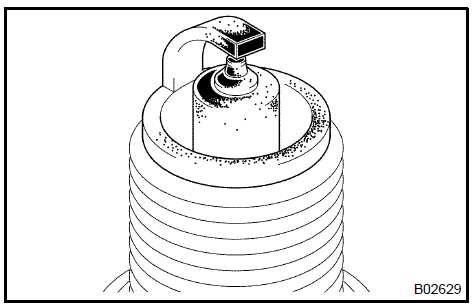
d. Check the spark plug electrode gap.
Maximum electrode gap for used spark plug: 1.3 mm (0.051 in.)
If the gap is greater than the maximum, replace the spark plug.
Correct electrode gap for new spark plug: 1.0 to 1.1 mm (0.039 to 0.043 in.)
NOTICE: If adjusting the gap of a new spark plug, bend only the base of the ground electrode. Do not touch the tip. Never attempt to adjust the gap on a used plug.
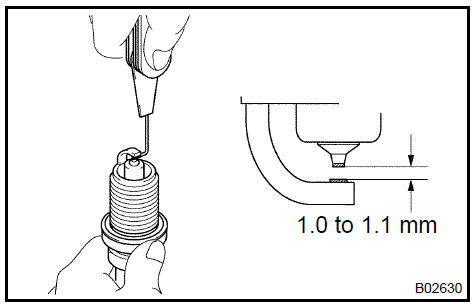
e. Clean the spark plugs.
If the electrode has traces of wet carbon, clean the electrode with a spark plug cleaner and then dry it.
Air pressure: 588 kPa (6 kgf/cm2, 85 psi) Duration: 20 seconds or less
HINT: Only use the spark plug cleaner when the electrode is free of oil. If the electrode has traces of oil, use gasoline to clean off the oil before using the spark plug cleaner.
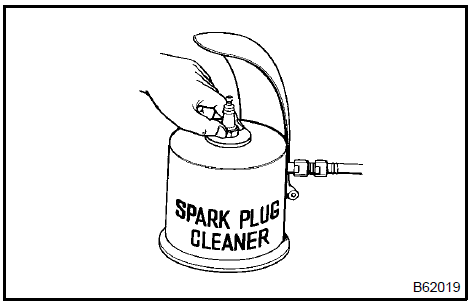
2. INSPECT VVT SENSOR (CAMSHAFT POSITION SENSOR)
a. Using an ohmmeter, measure the resistance between the terminals.
Standard
:

If the resistance is not as specified, replace the sensor.
3. INSPECT CRANKSHAFT POSITION SENSOR
a. Using an ohmmeter, measure the resistance between the terminals.
Standard
:

If the resistance is not as specified, replace the sensor.
Ignition system (2AZ−FE)(From July, 2003)
VVT sensor (1MZ−FE/3MZ−FE)
Crankshaft position sensor (1MZ−FE/3MZ−FE)
Ignition system (2AZ−FE)(From July, 2003)
Camshaft position sensor (2AZ−FE)(From July, 2003)
Crankshaft position sensor (2AZ−FE)(From July, 2003)
Ignition system (1MZ−FE/3MZ−FE)
Toyota Camry XV30 (2002–2006) Service Manual
- Introduction
- Audio & visual system
- Automatic transmission / trans
- Brake
- Clutch
- Communication system
- Cooling
- Cruise control
- Drive shaft / propeller shaft
- Emission control
- Engine control system
- Engine hood/door
- Engine mechanical
- Exhaust
- Exterior/interior trim
- Front suspension
- Fuel
- Heater & air conditioner
- Ignition
- Instrument panel/meter
- Intake
- Lighting
- Lubrication
- Manual transmission/transaxle
- Parking brake
- Power steering
- Rear suspension
- Seat
- Service specifications
- Sliding roof/convertible
- Starting & charging
- Steering column
- Supplemental restraint system
- Theft deterrent & door lock
- Tire & wheel
- Windshield/windowglass/mirror
- Wiper & washer
- Wiring
